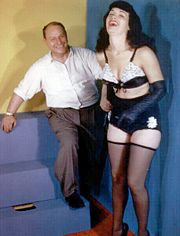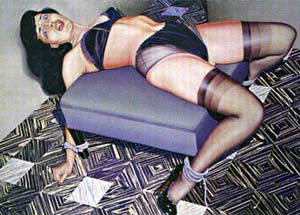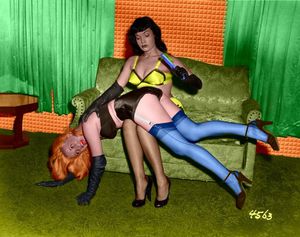Bettie Page


Bettie Mae Page, also known as Betty Page (April 22, 1923 - December 12, 2008) was a United States model, the subject of numerous "pin-up girl" photographs in the mid 20th century.
She was born in Nashville, Tennessee. Page's parents divorced when she was 10 years old, forcing her and her sister to live for a year at an orphanage. A strong student in high school, she reportedly missed earning the title of school valedictorian and a scholarship to Vanderbilt University by a quarter of a grade point, but graduated from Peabody College with a Bachelors of Arts in 1943. She married Billy Neal, who had attended high school with her, but who shortly afterwards left her for active duty in World War II, and whom she divorced in 1947.
After working briefly in Haiti as a secretary at a furniture company, she moved to New York City, where she supported herself as a secretary while looking for work as an actress. While she appeared in a couple of Off-Broadway plays in 1956, Page found her fame and success in modelling, first for camera clubs, then later for commercial redistribution. She learned of this line of work through a chance encounter in 1950 with Jerry Tibbs on a deserted beach at Coney Island. Tibbs also suggested her trademark bangs.
At first Page posed for camera clubs, sometimes in the nude, because the photographs were not to be published. In 1951 her image appeared on the cover of men's magazines with names like Eyeful, Wink, Titter, Black Nylons, or Beauty Parade. At the same time she posed for photographer Irving Klaw for mail-order photographs with a bondage or sadomasochistic theme, making her the first famous bondage model.
During one of the annual pilgrimages to the sun, sand and surf she adored, Bettie Page met Bunny Yeager in Miami, Florida in 1954. At that time Page was the top pin-up model in New York, and Bunny Yeager an aspiring photographer. Bunny signed Page for a photo session at the now defunct USA Africa Wildlife Park in Boca Raton, Florida. The 'Jungle Bettie' photographs from this shoot are some of her most celebrated and include nude shots with a pair of cheetahs. The leopard skin patterned 'Jungle Girl' outfit she wore for the shoot was made by Bettie herself.
After Bunny Yeager sent shots of Bettie Page to Playboy founder Hugh Hefner, she was featured as "Playmate of the Month" and centerfold for Playboy magazine in its January 1955 issue. Bettie also became one of Hugh Hefner's obsessions. When Page was almost forced to file for bankruptcy, it was Hefner who bailed her out.
In an industry where the average career of a model was measured in months, Page was in demand for several years, modelling until 1957. Although she frequently posed in the nude, she never appeared in any scenes with explicit sexual content. When Howard Hughes, movie maker and billionaire, sent her a letter asking to meet her, she declined.
The reasons for her departure from modelling work are varied. Some authorities state she was burnt out and her marriage to Armand Walterson in 1958 was the cause. Others mention the "Kefauver Hearings" of the Subcommittee to Investigate Juvenile Delinquency in the United States, which ended Irving Klaw's mail-order photography business. In any case, shortly after her marriage to Walterson, she had a religious conversion December 31, 1958, and severed all contact with her prior life. For many years, the last known facts of her life was her divorce from Walterson in the early 1960s, and that she was working as a secretary for a Christian organization.
The Playboy model Barbi Benton revived interest in Page as some considered the younger woman to be in her image. Then in 1978, Belier Press began to reprint some of the pictures from the private camera club sessions, which reintroduced Page to a new generation. Within a few years, Page became an icon of the 1950s, her renewed fame rivalling Marilyn Monroe's.
In the early Eighties, Comic Book talent Dave Stevens based the love life of his hero Cliff Secord alias "The Rocketeer" on Page. A fanzine was started called The Betty Pages and recounted tales of the camera club days. When Bettie asked the fan club to stop, it did.
Dark Horse Comics published a comic based on her fictional adventures in the 1990s after Jim Silke did a large format comic featuring her likeness.
This renewed attention raised the inevitable question: what had happened to Bettie Page since the late 1950s? This question was answered in part with the publication of an official biography in 1996, Bettie Page: The Life of a Pin-up Legend. Her biography described a woman who dealt head-on with adversity, always looking forward, never looking back. It told how she had remarried her first husband briefly, in order to satisfy requirements so she could become a missionary; neither the remarriage nor her missionary work was a success. She married a third time in 1967 to one Harry Lear in Florida, divorcing him in 1972. At the time of the rebirth of her celebrity, Page was living penniless in California, unaware of her renewed celebrity. She hoped that with the efforts of her co-author and agent, James Swanson, she would be seeing some financial reward for this renewed attention.
A second biography, written by Richard Foster and published in 1997, The Real Bettie Page: The Truth about the Queen of Pinups, tells a less happy tale. It details not only numerous accounts of violence on her part against not only her third husband and her two step-children, but also against other people, but several stays in mental institutions, the last one from 1983 to 1992 at Patton State Hospital in Highland, California. It also furnished information that Page had still not received all of the monies due to her since her rediscovery.
Foster's book immediately provoked attacks from her fans, including Hefner, and Harlan Ellison, as well as a statement from Page that it is "full of lies." However, Steve Brewster, founder of the Bettie Scouts of America fan club has stated that it is not as unsympathetic as the book's reputation makes it to be. Brewster adds that he also read the chapter about her business dealings with Swanson, and stated that Page was pleased with that part of her story.
In a recent interview, Page has stated she will not allow any current pictures of her to be shown, because she is 25 to 30 pounds overweight. A friend believes the reason for her reluctance is more likely insecurity. "If your grandmother looked like Bettie does today, you'd be thrilled. Her eyes still sparkle. She really looks like her old self."
A film of her life, "The Notorious Bettie Page", was released in 2006 (UK première 4th August 2006).
See also
References and further reading
- Essex, Karen, and James L. Swanson. Bettie Page: The Life of a Pin-Up Legend. Los Angeles: General Publishing Group, 1996. ISBN 1881649628.
- Foster, Richard. The Real Bettie Page: The Truth About the Queen of the Pinups. Secaucus, N.J.: Carol Publishing Group/Birch Lane Press, 1997. ISBN 1559724323.

